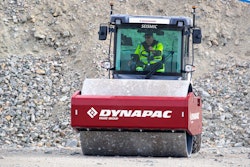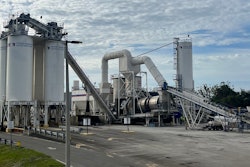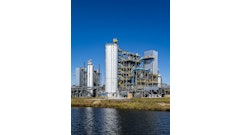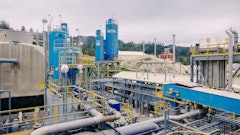
The construction industry is beginning to feel the slow, inexorable push to go green. This is because our current reliance on nonrenewable energy sources is starting to cause problems in the sector and beyond. For example, in the U.S. construction sector, almost 98 percent of all energy use comes from diesel.
This is a problem for multiple reasons. First, just last year, diesel prices soared by 33 percent. Second, nonrenewable energy sources are finite and in increasingly short supply. And while countries are unlikely to run out of traditional fuels in the short term, limited quantities and supply chain disruptions are a very real facet of our industry. Finally, the CO2 emissions that result from the use of nonrenewable energy sources pose a harmful threat to our greater environment. As a result, the construction industry faces no other option but to shift to cleaner, renewable, and more eco-friendly energy sources.
The construction industry’s reliance on traditional energy sources is holding it back, but there are a plethora of new green solutions ready for the taking. Let’s dive into the ways the sector can reduce its reliance on fossil fuels and transition to cleaner energy sources.
Two Promising Alternatives
The simplest, easiest way to reduce reliance on fossil fuels is by finding suitable energy alternatives. “Suitable” in this case means finding a solution that is equal to or lesser in cost than traditional fuels sources, otherwise there would be reduced incentive for construction companies to switch, that at the same time results in less CO2 emissions. It also means readily accessible in the large quantities that the construction industry requires. Otherwise, construction companies would be subject to the same issues that we have with diesel today. Two possible answers that fit the bill are zero-emission hydrogen and battery-electric vehicles.
Turquoise hydrogen is one method of hydrogen energy production that has substantial benefits for the construction industry. In this method it is generated through a thermal reaction with carbon black as the only co-product, resulting in zero carbon emissions and a potential energy source replacement for traditional fossil fuels such as diesel.
The downside is that these technologies have not yet been adopted at a large scale. Hydrogen fuel cell vehicles and equipment are more expensive than their diesel counterparts, plus the production of hydrogen itself has traditionally been costly. However, as technology matures and production scales up, these costs will naturally decrease. One fascinating study estimated that by 2050, the total cost of ownership for hydrogen fuel cell electric vehicles will be lower than that of diesel vehicles. In other words, we’re not there yet, but early adoption now will prove fruitful in the long-term.
One England-based company called HiiROC offers a technology that significantly decreases the cost of hydrogen fuel production. HiiROC uses a unique plasma process to produce turquoise hydrogen that is more efficient and less energy-intensive than traditional methods like water electrolysis, steam methane reforming and pyrolysis. Their technology is currently being tested in heavy emitting construction processes such as cement production to increase cement producers hydrogen injection capacity, allowing for a higher alternative fuel substitution rate of fossil fuels.
The same study also looked at several scenarios in which battery-electric construction equipment, powered by renewable energy sources, could be a financially viable alternative to diesel. For the majority of vehicles considered in the study, battery-electric vehicles had the lowest cost per km, unless specific diesel taxes or surcharge incentives were implemented.
As with hydrogen fuel cell vehicles, battery-electric equipment would not only cut emissions but also offer long-term cost savings, given the decreasing costs of renewable energy technologies. Electric construction vehicles are already making their way onto the market, with companies like Volvo and Caterpillar investing in electric loaders and excavators.
As with every new technology, however, there are limitations that are being actively improved by public and private research and development teams.
 Electric construction vehicles are already making their way onto the market, with companies like Volvo investing in electric loaders and excavators.CEMEX
Electric construction vehicles are already making their way onto the market, with companies like Volvo investing in electric loaders and excavators.CEMEX
Collaborations is Key
How can construction companies speed up the process of finding cheaper, more efficient energy sources? One of the best ways to foster innovation is by collaborating with startups, leading companies, and public organizations, both those directly related to and adjacent to the construction industry.
Universities, for instance, are hotbeds of research and innovation, particularly in fields like renewable energy and sustainable technologies. Construction companies can partner with academic institutions to access cutting-edge research, participate in pilot projects, and even provide guidance and direction to researchers by offering practical insights and communicating industry requirements.
Inter-industry partnerships are also another source of innovation. Two companies, each one in a different industry, can complement each other’s strengths and provide new perspectives on an old problem.
Another great source of collaborative innovation is partnering with startups. The construction industry can feel a bit stagnant at times, replete with lots of old, big, slow-moving players. But there are plenty of exciting startups in the space with fresh ideas that can help shift the industry towards alternative fuel sources.
For example, in 2022 Cemex Ventures invested in and partnered with WtEnergy, a clean energy startup that converts biomass and non-recyclable waste into a lower-carbon fuel. As the open innovation unit of Cemex, a leading multinational building materials company, this partnership aims to replace fossil fuels with clean energy in the clinker and cement manufacturing process. And in 2023, Cemex received a €4.4 million grant from the European Union to implement this technology in its Alicante, Spain cement plant.
Ultimately, collaboration and innovation go hand-in-hand. Partnerships like these can go a long way to helping the construction industry become greener faster.
Benefits Beyond the Construction Industry
If you think about it, construction is the backbone of our modern society – the houses we live in, the roads we drive on, and the office buildings we work in all make up our built environment. So a greener construction industry makes an impact on the lives of everyone.
For one, we can count on an immediate benefit in the form of better urban air quality. Construction sites are responsible for 14.5 percent of particulate matter in the air and 8 percent of total emissions in the United States. By switching to cleaner energy sources, the amount of harmful emissions in the air will decrease significantly, particularly in densely populated urban areas.
Another area of improvement is in greenhouse gas emissions. Globally, in developed and developing countries, construction and building operations contribute to 33 percent of greenhouse gas emissions and 40 percent of global energy consumption. By adopting alternative fuel sources like hydrogen fuel cells and battery-electric vehicles, the industry can significantly reduce the world’s carbon footprint, not just its own.
The transition to greener energy sources can also stimulate economic growth by creating new markets and job opportunities. This includes jobs in renewable energy sectors, such as solar and wind power, and in the development and maintenance of new, cleaner construction technologies.
As a side effect, of course, there will be a decrease in the number of fossil fuel-related jobs. One analysis conducted by Princeton researchers estimates that by 2030, fossil fuel energy jobs in the United States could decrease by 131,000 to 210,000 positions. But the study also estimates that the switch will create somewhere between 777,000 to 5.1 million new energy-related jobs.
Finally, the construction industry's move towards sustainability could also set a precedent for other sectors. This would be a welcome change. The construction industry has a reputation for being slow and resistant to change. Almost two-thirds of architecture, engineering, and construction professionals believe that the industry is not evolving fast enough to meet society’s changing needs.
There’s a reason for that – one McKinsey study found that the construction industry lags behind others in innovation. Less than 1 percent of construction companies’ revenue goes back into technology research and development, compared to 3.5 percent invested by the automotive industry and 4.5 percent by aerospace companies.
As one of the most resource-intensive industries, construction should set an example by successfully transitioning to cleaner energy sources. This would serve as a powerful example for other industries, accelerating the overall shift towards sustainability.
The construction industry is currently in a unique position. It is clear that going forward with fossil fuels will not be a viable long-term option to power construction processes. Hopefully, this article has illustrated some tenable possible alternatives, inspired potential partnerships, and offered benefits beyond the long-term financial reasons to shift away from fossil fuels and nonrenewable energy sources. It’s time for the construction industry to go green and some companies are already making the switch.



















